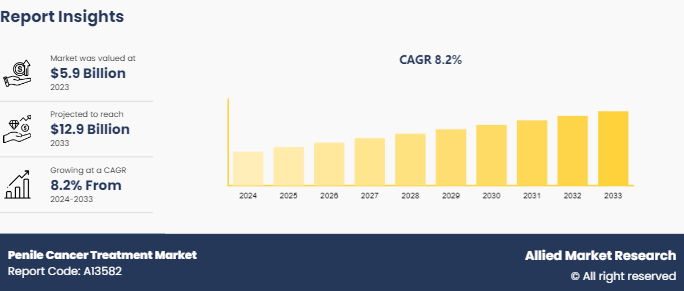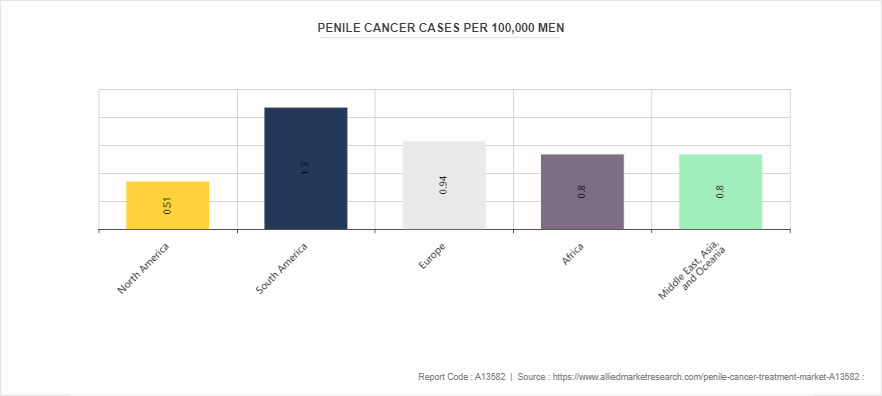Penile Cancer Treatment Market Research, 2033
The global penile cancer treatment market size was valued at $5.9 billion in 2023, and is projected to reach $12.9 billion by 2033, growing at a CAGR of 8.2% from 2024 to 2033. The growth of the penile cancer treatment market is primarily driven by increasing awareness of penile cancer, advances in medical research, and the development of targeted therapies. The rising prevalence of risk factors, such as HPV infection and smoking, contributes to the demand for effective treatments. In addition, improvements in healthcare infrastructure, along with ongoing clinical trials for innovative treatments, further fuel market expansion. The availability of minimally invasive treatment options also plays a significant role in market growth.

Market Introduction and Definition
Penile cancer treatment typically involves a combination of surgery, radiation, and chemotherapy, depending on the cancer's stage and location. Early-stage penile cancer may be treated with localized therapies like surgery to remove the tumor or partial penile amputation, preserving as much function as possible. In more advanced cases, total penectomy (removal of the penis) may be required. Radiation therapy is often used as a supplementary treatment to shrink tumors or after surgery to eliminate any remaining cancerous cells. Chemotherapy is patients with advanced or metastatic penile cancer to target cancer cells throughout the body. For patients with lymph node involvement, lymphadenectomy (removal of affected lymph nodes) may also be part of the treatment plan. In addition to traditional therapies, clinical trials exploring immunotherapy and targeted therapies are providing new options for managing penile cancer, improving outcomes and preserving quality of life for patients.
Key Takeaways
- The Penile Cancer Treatment market share study covers 20 countries. The research includes a segment analysis of each country in terms of value for the projected period.
- More than 1, 500 product literatures, industry releases, annual reports, and other such documents of major Penile Cancer Treatment industry participants along with authentic industry journals, trade associations' releases, and government websites have been reviewed for generating high-value industry insights.
- The study integrated high-quality data, professional opinions and analysis, and critical independent perspectives. The research approach is intended to provide a balanced view of global markets and to assist stakeholders in making educated decisions in order to achieve their most ambitious growth objectives.
Key Market Dynamics
According to penile cancer treatment market forecast analysis, the key factors driving the growth of the market are increasing penile cancer incidence, growing awareness about penile cancer and improvements in healthcare infrastructure, and increased healthcare spending. The rise in the prevalence of penile cancer is a significant driver for the growth of the penile cancer treatment market. Several factors contribute to this increase, including lifestyle changes, the aging population, and the rising incidence of risk factors such as human papillomavirus (HPV) infection, smoking, and poor hygiene. As awareness of penile cancer improves, early detection and diagnosis rates have also risen, prompting greater demand for treatment options. In addition, the growing emphasis on cancer treatment advancements, such as targeted therapies and immunotherapy, has spurred innovation in treatment modalities for penile cancer, which is relatively rare compared to other types of cancer. Thus, the growing prevalence of the penile cancer is expected to contribute significantly in the penile cancer treatment market growth.
According to penile cancer treatment market opportunity analysis rise in awareness about penile cancer is a significant driver for the penile cancer treatment market. As more individuals, healthcare providers, and advocacy organizations educate the public about the signs, risks, and prevention of penile cancer, early detection has become increasingly prevalent. This awareness helps to reduce the stigma surrounding the disease, encouraging individuals to seek medical attention promptly if symptoms arise. Public health campaigns, as well as increased media coverage and research initiatives, contribute to this growing knowledge base. As a result, patients are more likely to pursue treatment options sooner, leading to higher demand for therapies such as surgery, chemotherapy, radiation, and immunotherapy. In addition, improved awareness fosters more support for clinical trials and the development of innovative treatments, further expanding the market. Increased healthcare provider training on penile cancer also plays a role in better diagnosis and treatment, ensuring that more patients have access to appropriate care. Thus, the rise in awareness about early treatment of penile cancer is expected to drive the penile cancer treatment market growth.
Penile Cancer Incidence Rate Over the World
The rising incidence of penile cancer globally is significantly impacting the penile cancer treatment market size by driving demand for advanced diagnostic and therapeutic solutions. Penile cancer is relatively rare, but its prevalence varies across regions, influencing market dynamics. For instance, South America reports the highest incidence, with 1.3 cases per 100, 000 men, followed by Europe at 0.94 cases per 100, 000 men. In Africa and regions including the Middle East, Asia, and Oceania, the incidence rate is 0.8 cases per 100, 000 men, while North America shows the lowest incidence at 0.51 cases per 100, 000 men. These disparities in incidence rates highlight a greater need for awareness, early detection, and treatment options in regions with higher prevalence, such as South America and parts of Africa and Asia. This growing incidence is driving investments in innovative treatment modalities, including targeted therapies, immunotherapy, and minimally invasive surgical procedures, thereby fueling the growth of the penile cancer treatment market.

Market Segmentation
The penile cancer treatment industry is segmented on the basis of type, stage, therapy type, treatment, route of administration, end user, and region. By type, the market is classified into in squamous cell cancer of penis, adenocarcinoma of penis, basal cell cancer of penis, and others. By therapy type the market is divided into chemotherapy, radiation therapy, biological therapy, photodynamic therapy, and antibiotic therapy. By treatment, the market is divided into drugs, and surgery. By route of administration the market is divided into oral, injectable, and topical. By end user, the market is divided into hospitals, homecare, specialty clinics, and others. Region wise, the market is analyzed across North America, Europe, Asia-Pacific, and LAMEA.
Regional/Country Market Outlook
North America dominated the Penile Cancer Treatment market share in 2023. This is attributed to well-established healthcare facilities, growing prevalence of penile cancer, and high healthcare spending in North America. However, the Asia-Pacific region is expected to register the highest CAGR. The region is experiencing a rising incidence of cancer due to lifestyle changes, urbanization, and an aging population. This trend is leading to a greater demand for treatment products, thereby driving the need for penile cancer treatment. Countries like India and Thailand are becoming popular destinations for medical tourism. The influx of international patients seeking advanced medical care is boosting the demand for penile cancer treatment market in Asia-Pacific.
- According to the National Cancer Center of Japan, there were estimations of 1, 019, 000 new cancer cases and 380, 400 cancer deaths in 2022.
- According to Government of India, the medical tourism in India has increased by 65.79%.
- According to the European Commission, As of 1 January 2023, around 21.3% of European population was aged 65 years and over.
- According to Invest India’s Investment Grid, there are nearly 600 investment opportunities worth $32 Billion in the country’s hospital/medical infrastructure sub-sector.
- According to 2023 article by National Library of Medicine, North America has historically a low incidence of penile cancer with an ASR of 0.51 cases per 100.000 men.
- According to a 2023 article by the National Library of Medicine, South America is one of the areas with the highest number of penile cancer cases in the World with a total of 4988 in 2021.
Industry Trends
- According to National Library of Medicine, Globally, the estimated age-standardized incidence rate was 0.80 (per 100, 000) and age-standardized mortality rates was 0.29 (per 100, 000) in 2020, equating to 36, 068 new cases and 13, 211 deaths in 2020, respectively.
- According to American Society of Cancer, in 2024, About 2, 100 new cases of penile cancer is expected to be occur in U.S.
- According to Cancer Research UK, Penile cancer incidence rates are projected to rise by 9% in the UK between 2023-2025 and 2038-2040.
Competitive Landscape
Penile Cancer Treatment market report summarizes top key players overview as F. Hoffmann-La Roche Ltd, Novartis AG, Pfizer Inc, Merck & Co., Inc, GSK plc, Cipla Inc, Teva Pharmaceutical Industries Ltd, Fresenius Kabi AG, Sanofi, Mylan N.V. Other players in the Penile Cancer Treatment market are Bristol-Myers Squibb, Amneal Pharmaceuticals LLC, and Intas Pharmaceuticals Ltd
Key Benefits for Stakeholders
- This report provides a quantitative analysis of the market segments, current trends, estimations, and dynamics of the penile cancer treatment market analysis from 2024 to 2033 to identify the prevailing penile cancer treatment market opportunities.
- The market research is offered along with information related to key drivers, restraints, and opportunities.
- Porter's five forces analysis highlights the potency of buyers and suppliers to enable stakeholders make profit-oriented business decisions and strengthen their supplier-buyer network.
- In-depth analysis of the penile cancer treatment market segmentation assists to determine the prevailing market opportunities.
- Major countries in each region are mapped according to their revenue contribution to the global market.
- Market player positioning facilitates benchmarking and provides a clear understanding of the present position of the market players.
- The report includes the analysis of the regional as well as global penile cancer treatment market trends, key players, market segments, application areas, and market growth strategies.
Penile Cancer Treatment Market Report Highlights
| Aspects | Details |
| Market Size By 2033 | USD 12.9 Billion |
| Growth Rate | CAGR of 8.2% |
| Forecast period | 2024 - 2033 |
| Report Pages | 280 |
| By Type |
|
| By Therapy Type |
|
| By Treatment |
|
| By Route Of Administration |
|
| By End User |
|
| By Region |
|
| Key Market Players | Pfizer Inc, F. Hoffmann-La Roche Ltd., Novartis AG, Teva Pharmaceutical Industries Ltd, Mylan N.V., Cipla Ltd., Sanofi, Merck & Co., Inc., GSK plc., Fresenius Kabi AG |
The total market value of Penile Cancer Treatment market is $5.9 billion in 2023
The forecast period for Penile Cancer Treatment market is 2024-2033.
The market value of Penile Cancer Treatment market is projected to reach $12.9 billion by 2033
The Penile Cancer Treatment market growth is driven by increasing penile cancer incidence, growing awareness about penile cancer and improvements in healthcare infrastructure, and increased healthcare spending
The base year is 2023 in Penile Cancer Treatment market
Loading Table Of Content...



